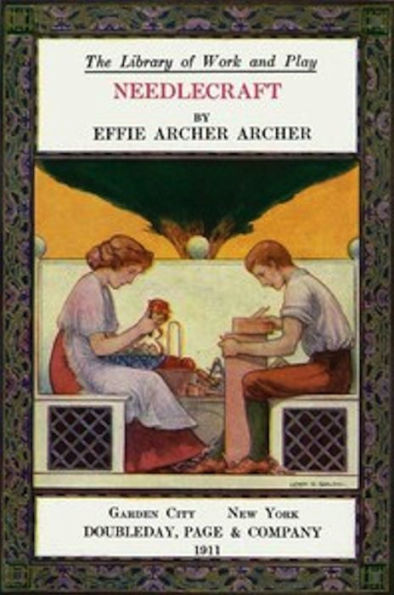You will find that you are happiest when doing things for those you love; and what greater help can you give than by learning to do things for yourself that now those who love you best do for you? The little everyday things that appear to be so simple, yet take so much of the mother's time should be the things first to learn. There are so many things that one could do if one only knew how, that it seems a shame to waste time. Dolly needs new clothes, mother always needs help with her sewing; and then, too, the numerous birthdays and Christmases follow so quickly one on top of another, that there is hardly a chance to save up for one before the next is here. Many a hard problem for the little mother will be solved in this book.
It is lovely to have a little work-box fixed up with thread, needles, and scissors, all of your own, and if you ask mother, I am sure she will give some of[4] her threads to help you start one. If you take a card and shape it like a Maltese cross you will have space for four colours of threads. You will need a card for the white alone because you will find you use so much more of it. You must have a little thimble and always use it or your finger will look cramped when working. Have you noticed how pretty ladies look when sewing? Well, you must do as they do, tap your needle with the thimble to send it through the material (Figure 1).
Fig. 1. The way to use your thimble
Have you ever wondered and wondered why it is that buttons have the horrid habit of dropping off just when you wanted to dress quickly or take Sally Ann walking? Well, I will whisper the reasons for this: the first is, that the thread might have been worn out from active service; or the thread used might have been weak; or lastly, which is probably the true cause, the button might have been sewn too close to the material and came off the first time it was used. Mother may not be around to help you when the accident happens, and would you not feel proud to sew it on for yourself?
To sew a button on securely you should make a[5] pin-hole where the button is to be placed. A four-hole white button is the easiest to work on. Thread a No. 7 needle with a length of No. 40 white sewing cotton, bring the ends together and make a knot. The right length thread is measured from the tip of the thimble finger to the elbow. When a thread is used double it should be twice the length of this. A neat knot is made by holding the threaded needle in the right hand and by taking the end or ends, as the case may be, between the thumb and first finger of the left hand. Keep the thread tightly stretched, wind it around the top of the first finger, then move the finger down the thumb, carrying the thread with it about half an inch. Now with the nail of the second finger bring the knot thus formed to the end of the thread.
A large ungainly knot is a disfigurement to a piece of sewing. You are now ready to adjust the button; place the knot on the upper or right side so that it will be concealed; after adjusting the button put a pin across the top and sew securely through the holes, crossing the threads. Sew not less than three times through each hole. Remove the pin. Insert the needle from underneath, then bring it out between the button and cloth close to the centre of the button. Wind the thread tightly[6] around the neck of the button three or four times. (The neck is the threads between the button and material.) Wrapping the threads around protects the stitches and allows room for the buttonhole to lie under the button. Take the thread through to the wrong side and take up three stitches, make a short stitch on the material and cut the thread close (Figures 2 and 3).
Figs. 2 and 3
When a three-hole button is used the stitches form a triangle on the top of the button. A shoe-button should be sewed with a No. 2 needle and coarse black thread. The stitches are taken through the shank of the button. Fasten off the thread after sewing on two buttons, for if they are all on one continuous string or thread and that breaks, all the buttons are apt to come off. If each button is securely fastened the thread may be passed, however, from one to the other.



